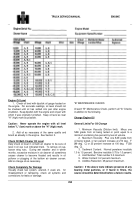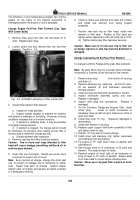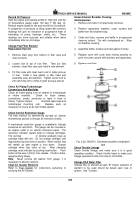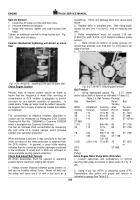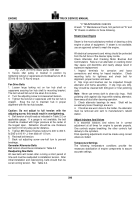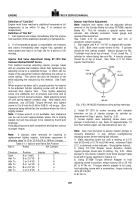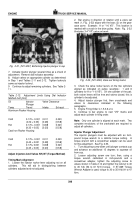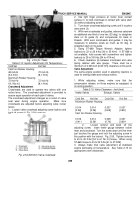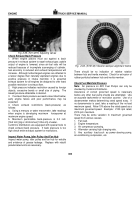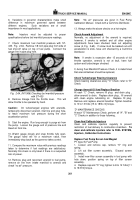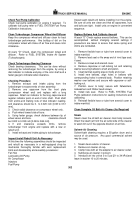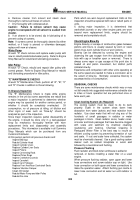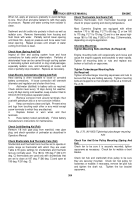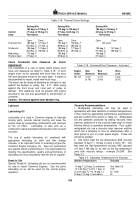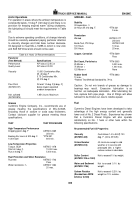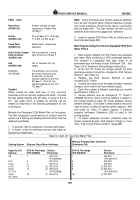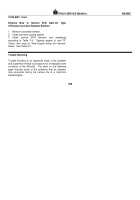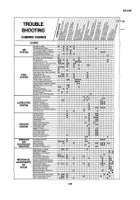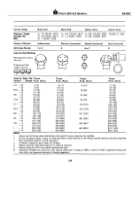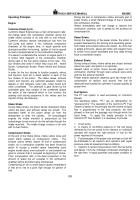TM-5-3805-254-14-P-2 - Page 306 of 894
TRUCK SERVICE MANUAL
ENGINE
Check Fuel Pump Calibration
Check fuel pump calibration on engine if required.
To
calibrate fuel pump refer to FUEL SYSTEM Fuel Pump
Calibration Instructions.
Clean Turbocharger Compressor Wheel And Diffuser
Keep the compressor wheel and diffuser clean for best
turbocharger performance.
Any buildup of dirt on the
compressor wheel will choke off air flow and cause rotor
imbalance.
At every "D" Check, clean the compressor wheel and
diffuser.
Refer to FUEL SYSTEM, Intake Air System
(Turbochargers).
Check Turbocharger Bearing Clearance
Check bearing clearances.
This can be done without
removing the turbocharger from the engine, by using a
dial indicator to indicate end-play of the rotor shaft and a
feeler gauge to indicate radial clearance.
Checking Procedure
1.
Remove exhaust and intake piping from the
turbocharger to expose ends of rotor assembly.
2.
Remove one capscrew from the front plate
(compressor wheel end) and replace with a long
capscrew.
Attach an indicator to the long capscrew and
register indicator point on end of rotor shaft.
Push shaft
from end-to-end making note of total indicator reading.
end clearance should be 0.
to 0.020 inch [0.08 to 0.51
mm].
3.
Check radial clearance on compressor wheel only.
a.
Push wheel toward side of bore.
b.
Using feeler gauge, check distance between tip of
wheel vanes and bore.
clearance should
be 0.003 to 0.033 inch [0.08 to 0.84 mm].
4.
If
end
clearance
exceeds
limits,
remove
turbocharger from engine and replace with a new or
rebuilt unit.
5.
Install exhaust and intake piping to turbocharger.
Inspect/Install Rebuilt Unit As Necessary
At this time the following assemblies should be inspected
and rebuilt as necessary in a well-equipped shop by
mechanics thoroughly familiar with worn replacement
limits and disassembly and assembly procedures:
Fan Hub
Lubricating Oil Pump
Air Compressor
Injectors
Fuel Pump
Inspect each rebuilt unit before installing it on the engine.
Be sure all units are clean and that all capscrews, nuts
and bolts are tight.
Install units on engine in convenient
sequence;
Replace Bellows And Calibrate Aneroid
At each "D" Check replace aneroid bellows.
This can be
accomplished
without
changing
aneroid
settings
if
precautions are taken to assure that same spring and
shims are reinstalled.
1.
Remove flexible hose or tube from aneroid cover to
intake manifold.
2.
Remove lead seal or file away end of rivet type seal,
if used.
3.
Remove screws and aneroid cover.
4.
Remove capscrew or self-locking nut and retaining
washer securing bellows to shaft and piston.
5.
Clean bellows sealing area on body and cover.
6.
Install new bellows, align holes in bellows with
corresponding holes in aneroid body.
Position retaining
washer over bellows and secure with capscrew or self-
locking nut.
7.
Position cover to body; secure with flatwashers,
lockwashers and fillister head screws.
8.
Install new seal.
Refer to FUEL SYSTEM, Fuel
Pump calibration instructions for sealing instructions and
calibrating.
9.
Reinstall flexible hose or tube from aneroid cover to
intake manifold.
Clean Complete Oil Bath Air Cleaner (As Required)
Steam
Steam clean the oil bath air cleaner main body screens.
Direct the steam jet from the air outlet side of the cleaner
to wash dirt out in the opposite direction of air flow.
Solvent-Air Cleaning
Solvent-bath cleaning requires a 55-gallon drum and a
source of air pressure.
Any good commercial solvent
may be used.
1.
Steam clean exterior of cleaner.
2.
Remove air cleaner oil cup.
3.
Clamp hose with air line adapter to air cleaner outlet.
4.
Submerge air cleaner in solvent.
5.
Introduce air into unit at 3 to 5 psi [21 to 34 kPa] and
leave in washer 10 to 20 minutes.
302
Back to Top

